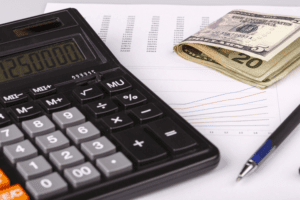
It typically refers to the selling price of the asset after its useful life is over. You can calculate this by an estimation method or by using the depreciation method. Using this method, you can calculate salvage value at the time of selling the asset.

Concave Calculator: Analyze Function Concavity

The Insurance Company will use their salvage car value calculator and deduct what they believe they can get for the wreck at auction, plus the regular deductions, and cut you a check. You can do some negotiating here since you are saving them the leg work involved in disposing of the totaled vehicle. An auction may be weeks or months away, so they don’t have to pay for storage either.

Salvage Value Calculator: Estimate Your Asset’s End-of-Life Value

It is an important factor to consider in capital expenditure analysis, as it affects the net present value (NPV) and internal rate of return (IRR) of a project. We will also provide some examples and tips on how to estimate and use salvage value in your calculations. Calculating depreciation with consideration of the salvage value ensures that the asset’s cost is accurately spread over its useful life. This provides a true reflection of the asset‚Äôs value and helps in presenting a more accurate financial position of the company. It is is an essential component of financial accounting, allowing businesses to allocate the cost of an asset over its useful life. One method of determining depreciation involves considering the asset’s salvage value.
Calculating Your Salvage Value and ACV
- In the example, the machine costs $5,000, has a salvage value of $1,000, and a 5-year life.
- Therefore, it is advisable to perform sensitivity analysis and scenario analysis to assess how different values and methods of salvage value affect the NPV and IRR of a project.
- When an asset or a good is sold off, its selling price is the salvage value if tax is not deducted then this is called the before tax salvage value.
- This is often heavily negotiated because, in industries like manufacturing, the provenance of their assets comprise a major part of their company’s top-line worth.
- Companies take into consideration the matching principle when making assumptions for asset depreciation and salvage value.
- They will also be able to calculate how long the machine is expected to be useful to a company based on how much the organization is going to use it.
- This value is typically estimated based on factors such as market conditions, asset condition, and demand.
Salvage value and depreciation are both accounting concepts that are related to the value of an asset over its useful life. Moving on, let’s look through the details of how the salvage value can be used in depreciation calculations. We can also define the salvage value as law firm chart of accounts the amount that an asset is estimated to be worth at the end of its useful life. This often involves dismantling and disposal costs, which can be offset by recycling or repurposing components.
- Scrap value is the worth of a physical asset’s individual components when the asset itself is deemed no longer usable.
- If the useful life of your asset has ended, the salvage value would typically be its actual market value at that point.
- It exhibits the value the company expects from selling the asset at the end of its useful life.
- It is is an essential component of financial accounting, allowing businesses to allocate the cost of an asset over its useful life.
- The double-declining balance method results in higher depreciation expenses in the beginning of an asset’s life and lower depreciation expenses later.
- The process of estimating the value of the salvage car involves several steps.
- Understanding salvage value is essential for businesses and individuals alike, as it helps in making informed financial decisions.
Use the purchase specification sheet if you have it from the time of purchase, or from the ownership papers to list all the extras on your car. You’ll need the year, make, model, mileage, and trim package, plus any extra equipment and add-ons. Some car dealers may offer between $250 and $500 for a totaled vehicle in trade when purchasing a replacement car if you bring it in.
- It is a method of recognizing the decline in value and the wear and tear of an asset over time.
- The balance sheet shows the net book value of an asset, which is the original cost minus accumulated depreciation, helping stakeholders understand the asset’s current worth.
- If you have deducted some depreciation expense, adjust the initial cost accordingly before applying the formula.
- Or, if they want to show more expenses early on, they might use a method that makes the item lose more value at the beginning (accelerated depreciation).
- This period varies based on factors like asset type, industry standards, and technological advancements.
Enter the asset name, purchase price, purchase date, and expected useful life.2. Click “Calculate Salvage Value” to see the estimated salvage value based on straight-line depreciation.3. Use the eBay market check feature to compare your estimate with current market prices.4. Depreciation schedules provide a detailed record of how assets depreciate over time, ensuring accurate financial reporting and compliance with accounting how to find salvage value standards. The original price or initial cost of an asset includes its purchase price, installation costs, and any other expenses incurred to bring the asset to a usable state. By considering the after-tax salvage value, businesses can make strategic decisions about whether to sell an asset or continue using it.
It represents the amount that could be obtained by selling the asset or using it for alternative purposes after accounting for depreciation. Essentially, it’s the bottom line value—an asset’s last hurrah before it bids adieu to the balance sheet. To learn more about this value and its importance for businesses, read this post till the end. Here, you will learn the formula for calculating this value and the various depreciation methods that affect it.
What Is Salvage Value in Accounting and How Is It Calculated?
Below is a break down of subject weightings in the FMVA® financial analyst program. As you can see there is a heavy focus on financial modeling, finance, Excel, business valuation, budgeting/forecasting, PowerPoint presentations, accounting and business strategy. Suppose a company spent $1 million purchasing machinery and tools, which are expected to be useful for five years and then be sold for $200k. There are six years remaining in the car’s total fixed assets useful life, thus the estimated price of the car should be around $60,000.